 “If a tree falls in the forest and no one hears it, did it really fall?”
“If a tree falls in the forest and no one hears it, did it really fall?”
Most people have heard this riddle before, although few know the origin of the phrase.
It comes from a book published in 1710 by George Berkeley called A Treatise Concerning the Principles of Human Knowledge.
The existential question he poses throughout the text is: Can something exist without being perceived?
Berkeley says no.
His theory is that if you have a message to share – but never share it – you never really had it in the first place.
The tree never (really) fell.
I agree.
And I think for anyone in a leadership position – personally or professionally – the “tree in the forest theory” is especially relevant when it comes to the topic of commitment.
Look: I know that you know…
Commitment is hard.
Commitment is essential.
Commitment is worth money.
Commitment is the cornerstone of good character.
Commitment is the keynote of inspirational leadership.
BUT HERE’S WHAT MOST PEOPLE MISS: Commitment requires consistent, visual and emotional reinforcement.
Otherwise you’re just winking in the dark.
THEREFORE: The problem is not a fear of commitment; the problem is a failure to communicate that you’re fully committed in the hearts and minds of the people who matter.
Today we’re going to explore part 1 (read part two next!) a collection of practices to help you communicate that you are fully committed:1. Differentiate between commitment and its substitutes. Just because you’re interested doesn’t mean you’re committed. Just because you care doesn’t mean you’re committed. Just because you show up doesn’t mean you’re committed. Just because you join doesn’t mean you’re committed.
And just because you feel obligated doesn’t mean you’re committed. In fact, just because you worked your ass off doesn’t mean you’re committed. Bummer.
But, it’s helpful to know the difference between commitment and these varieties of replacements thereof. Think of it like a breakfast table: The chicken is involved – but the pig is committed. What evidence have you given to people – this week – to assure them that you cluck instead of oink?
2. Chose your vehicle wisely. Like one of those racecar video games where you get to pick from any number of high-performance European cars before starting the race. Best part of the game. And this isn’t even about automobiles – this is about the vehicle of your commitment.
Look: I know you’re hesitant about what – specifically – you need to commit to. But if you listen deeply enough when the path to true commitment falls into your range of vision, the decision will make itself.
For example, I got a tattoo of a nametag on my chest. It symbolizes my commitment to my truth, my name, my identity, my philosophy and my life purpose. Plus chicks dig it. Hey: When in doubt, desecrate your body, right?
Anyway, there’s something exceptionally inspiring about committing yourself to the point of no turning back. Interestingly, I got my tattoo in 2005, which was right around the time my company first starting making money.
Huh. That’s interesting. I guess once you choose to commit with both feet, the world says yes to you. Providence moves to orchestrate the ideal conditions for you to make a name for yourself.
Remember: When you only commit with one foot, the other foot searches for reasons to discontinue efforts. Are you prepared to push all your chips to the center of the table?
3. Employ a commitment rich vocabulary. Strengthen your language when you talk about your commitments. For example, instead of saying, “I’ll try to,” or “I’ll get around to,” say “I commit to.” Instead of writing, “Our promise is,” write, “Our commitment is.”
Also, any time you take action that’s in line with your commitment, reinforce it by saying, “As promised, here is my…” or “As per our agreement, enclosed is…” Language like this demonstrates self-reliance and caring; articulates the gravity of your commitment and sticks in people’s memories forever. How do the words of your mouth reinforce the covenants of your heart?
4. Take a tip from the terrorists. You’ve got to hand it to those suicide bombers: They sure are committed. Too bad their efforts can’t be redirected into something that doesn’t murder thousands innocent people. Oh well.
Lesson learned: Commitment is a neutral article. Like good tofu, commitment takes on the flavor of whatever sauce it’s immersed in. This is a helpful analogy to keep in mind as you communicate that you’re fully committed to the people who matter.
Because if the cause you’re committed to is rooted in dishonesty, disrespect or depravity (thanks to my friends @ UIA FED for the link), all the commitment in the world won’t be able to stop you from hurting people. Including yourself.
Commitment becomes a detriment when values it’s in direct alignment with are rooted in evil. How are you laying an ethical foundation that builds your commitment?
5. Avoid compromising situations. Mr. Miyagi once said, “The best way to block a punch, is to not be there.” If you want to increase the probability that your commitment is consistently communicated, remember that truth. Also, remember this: What people think when they hear your life speak determines your leadership legacy.
The challenge is keeping yourself accountable. Here. Try posting these two questions in a visible location at your office: Do I want to become known for what I’m about to do? Have I been anywhere this week that might be seen as a compromise?
The good news is: This exercise requires the least amount of work – because all you have to do is say no. The bad news is, this practice requires the most amount of self-control – because saying no becomes seductively easy when saying yes would go undetected by the masses.
I learned this from experience. You only have to walk into a strip club wearing a nametag once. Would the person you want your people to see you as, do what you’re about to do?
REMEMBER: Commitment is nothing other than persistence with a purpose.
But.
Commitment is useless if not consistently communicated.
Commitment is irrelevant when the thing you’re committed to hurts people.
Commitment is worthless without the effective capacity to invest in and implement it.
On the other hand, commitment is a lifestyle that, if executed daily, becomes an equitable reputation – a tree falling in the forest – that the people who matter, hear.
LET ME ASK YA THIS…
How will you communicate that you’re fully committed?
LET ME SUGGEST THIS…
For the list called, “62 Pieces of Advice Busy Executives Need to Know, but Don’t Have Time to Learn on Their Own,” send an email to me, and I’ll send you the list for free!
* * * *
Scott Ginsberg
That Guy with the Nametag
Author, Speaker, Entrepreneur, Mentor
[email protected]
 Nobody seeing YOUR name anywhere?
Nobody seeing YOUR name anywhere?
Bummer. Perhaps my monthly coaching program would help.
Rent Scott’s Brain today!

 “My life is my preparation.”
“My life is my preparation.”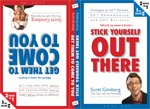 The world’s FIRST two-in-one, flip-flop book!
The world’s FIRST two-in-one, flip-flop book! And now for a few words from some dead white guys:
And now for a few words from some dead white guys:
 I saw Wicked for the first time last week.
I saw Wicked for the first time last week. Six hours from now, I’ll be taking center stage here in Denver for the Optimist International Convention.
Six hours from now, I’ll be taking center stage here in Denver for the Optimist International Convention.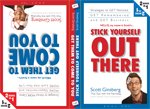 The world’s FIRST two-in-one, flip-flop book!
The world’s FIRST two-in-one, flip-flop book! For those of you human beings out there (and I think you know who you are) here’s a quick list of assumptions.
For those of you human beings out there (and I think you know who you are) here’s a quick list of assumptions. 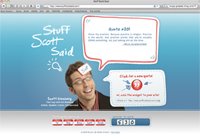 Who’s quoting YOU?
Who’s quoting YOU? I’m aware of the irony of publishing a list of instructions on how not to conform.
I’m aware of the irony of publishing a list of instructions on how not to conform. “Nobody’s reading your blog because of your art. They’re reading your blog because the person you are inspires them. They’re not reading your blog because they’re thinking of buying your paintings, they’re reading your blog because the way you approach your work inspires them. It sets an example for them. It stands for something that resonates with them. It leads them to somewhere that they also want to go.”
“Nobody’s reading your blog because of your art. They’re reading your blog because the person you are inspires them. They’re not reading your blog because they’re thinking of buying your paintings, they’re reading your blog because the way you approach your work inspires them. It sets an example for them. It stands for something that resonates with them. It leads them to somewhere that they also want to go.”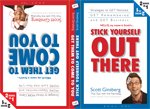 The world’s FIRST two-in-one, flip-flop book!
The world’s FIRST two-in-one, flip-flop book! It’s great to have people cheering for you.
It’s great to have people cheering for you.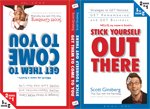 The world’s FIRST two-in-one, flip-flop book!
The world’s FIRST two-in-one, flip-flop book! “There’s more to life than just being a passenger.”
“There’s more to life than just being a passenger.”